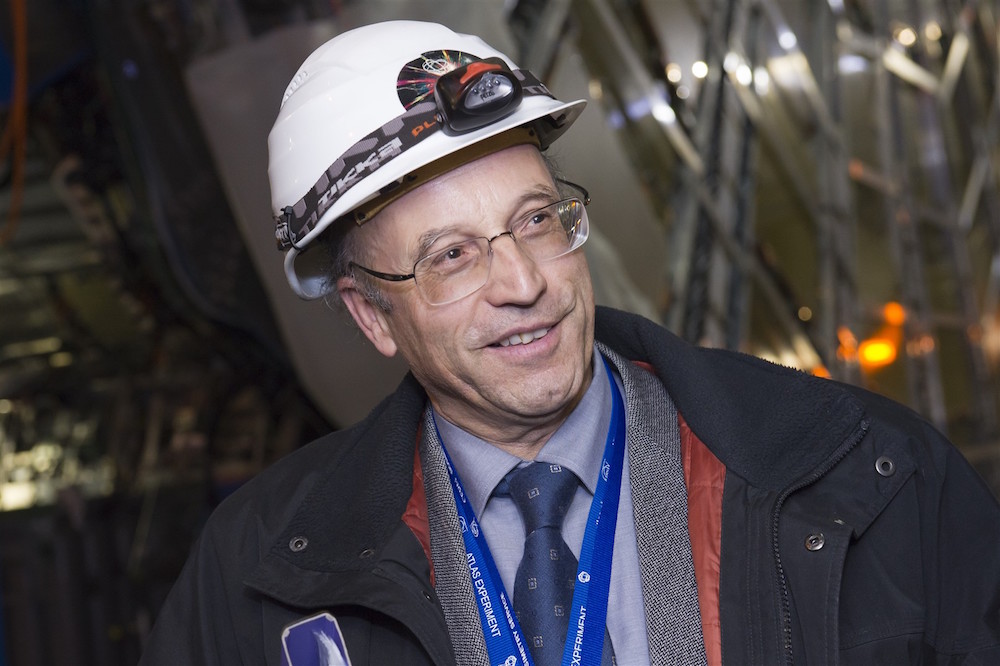Pauli Lectures 2014
The Wolfgang Pauli Lectures 2014 were dedicated to physics.
Prof. Gian Francesco Giudice
CERN, Geneva

Gian Francesco Giudice is a theoretical particle physicist working at the CERN Theory Group. After graduating from the University of Padua, he obtained his PhD in theoretical physics in 1988 from SISSA in Trieste. He worked at the Fermi National Accelerator Laboratory, near Chicago, and at the University of Texas, in the group of Prof. S. Weinberg, before moving to CERN in 1993. His research focuses on the construction of new theories beyond the Standard Model of particle interactions and on their implications for the early history of our universe. Supersymmetry and extra dimensions are fields in which he has made fundamental contributions. Besides his research work, Giudice is active in the popularization of science and outreach. He is the author of A Zeptospace Odyssey, a popular-science book on the physics of the Large Hadron Collider. He has been awarded the 2013 Jacques Solvay Chair in Physics.
What the Higgs Boson Teaches Us about Nature
Monday, May 5, 2014, 20:15 h Auditorium Maximum, HG F 30
The discovery of the Higgs boson has electrified the scientific world because it clarified the dynamics underlying one of the basic ingredients of the fundamental laws of nature. This discovery has shed new light on how symmetries are realized in nature and their role in the evolution of the universe. But this discovery, while providing answers to some issues that have puzzled physicists for decades, has opened new questions and new conundrums about what lies behind the Higgs boson. Theoretical physicists are eagerly waiting for new data from the upcoming highenergy phase of the LHC to make full sense of the intriguing story of the Higgs boson.
Prof. Peter Jenni
University of Freiburg (Germany) and CERN, Geneva

Peter Jenni obtained his Diploma for Physics at the University of Bern in 1973 and his Doctorate at ETH Zürich in 1976. During 1978/9, he was a Research Associate at the Stanford Linear Accelerator Centre (SLAC), USA. He became a CERN research staff physicist in 1980 with the UA2 experiment at the SPS pp_bar collider (with a major involvement in the discoveries of the W and Z bosons). His strong interest was with the Large Hadron Collider (LHC) since the beginning in 1984. From 1991 his main activities concentrated on building up of an LHC experiment. In 1995, after formal approval of the ATLAS project, he was elected its Spokesperson (project leader). He was re-elected several times, and retired from this duty in February 2009, retaining however a strong involvement in the operation and physics of the experiment. Since his retirement at CERN end of April 2013, Peter Jenni is a Guest Scientist with the Albert-Ludwigs-University Freiburg, Germany. He received (or shared) among others the Swiss Greinacher Prize, the Czech Academy of Sciences Ernst Mach Honorary Medal, the German Julius Wess Award, a share of the Special Fundamental Physics Prize (FPP), and a share of the High Energy and Particle Physics Prize of the European Physical Society (EPS). He also received honorary PhD degrees from the Universities of Stockholm and Copenhagen, and from the ETHZ.
The Long Experimental Journey of the Higgs Discovery at the LHC
Tuesday, May 6, 2014, 20:15 h Auditorium Maximum, HG F 30
Since three years the experiments at the Large Hadron Collider (LHC) investigate particle physics at the highest collision energies ever achieved in a laboratory. Following a rich harvest of results for Standard Model (SM) physics came in 2012 the first spectacular discovery, by the ATLAS and CMS experiments observing a new, heavy particle which is most likely the long-awaited Higgs boson. The latest results with the full data sets accumulated over the first three-year running period of the LHC will be presented. However, with this recent discovery of a heavy scalar boson the exciting journey into unexplored physics territory, within and beyond the SM, has only just begun at the LHC. Other results can be reported for exploratory new physics searches like Supersymmetry (SUSY), Extra Dimensions, and the production of new heavy particles.
Prof. Lyn Evans
CERN, Geneva

Born in 1945, Lyn Evans has spent his whole career in the field of high energy physics and particle accelerators, participating in all the great projects of CERN. Since 1993 he has led the team that designed, built and commissioned the LHC. He is presently a visiting professor at Imperial College London and Director of the Linear Collider Collaboration. Among his many honours he is a Fellow of the American Physical Society and a Fellow of the Royal Society. He was awarded a Fundamental Physics Prize in 2013 for his contribution to the discovery of the Higgs-like boson.
The Large Hadron Collider, a Marvel of Technology
Thursday, May 8, 2014, 20:15 h Auditorium Maximum, HG F 30
After 15 years in construction, the LHC has started its physics program with spectacular results. It is without doubt the most complex scientific instrument ever built, bringing together science and engineering on a grand scale. The 6000 superconducting magnets weighing nearly 50000 tons in total are cooled with 100 tons of superfluid helium. In this seminar, some of the unique design features of the LHC will be described and the trials and tribulations of bringing it all together are discussed.
